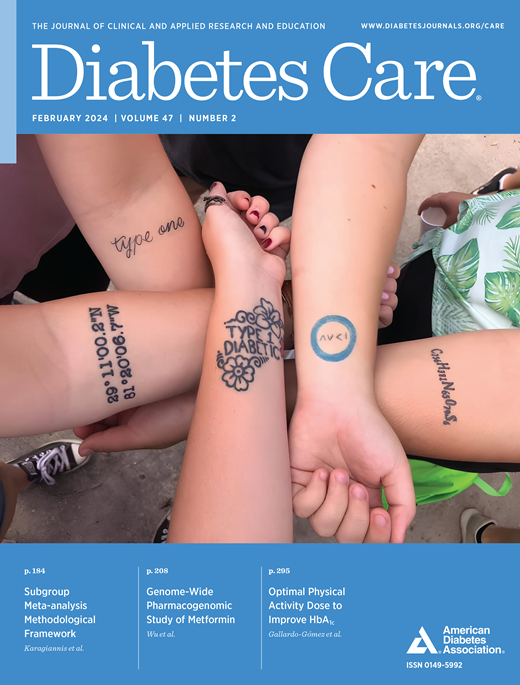High Prevalence of Prediabetes Among Asian and Pacific Islander Adolescents With Overweight or Obesity in a Primary Care Population
IF 16.6
1区 医学
Q1 ENDOCRINOLOGY & METABOLISM
引用次数: 0
Abstract
OBJECTIVE To compare prediabetes prevalence among disaggregated U.S. Asian and Pacific Islander (Asian/PI) adolescents with non-Hispanic White (NHW) adolescents with overweight or obesity in a primary care population. RESEARCH DESIGN AND METHODS This retrospective, cross-sectional study used Kaiser Permanente Northern California health record data. The cohort comprised 20,540 NHW and 16,508 Asian/PI adolescents aged 10–17 years with overweight (BMI 85th to <95th percentile) or obesity (BMI ≥95th percentile) at a pediatric visit (2012–2019) and HbA1c measured within 1 year. Those with HbA1c ≥6.5%, a diabetes diagnosis, or diabetes pharmacotherapy were excluded. Prediabetes was classified as HbA1c 5.7–6.4%. Adjusted prevalence ratios (aPRs) with 95% CIs for prediabetes were examined for Filipino, Chinese, South Asian, Vietnamese, and Native Hawaiian/Pacific Islander (NHPI) compared with NHW using modified Poisson regression, adjusting for age, sex, BMI, neighborhood deprivation index, and visit year. RESULTS Asian/PI adolescents with overweight or obesity had a higher prediabetes prevalence (26.9%) than NHW adolescents (11.9%) (P < 0.001), with variation among Asian subgroups of 31.0% for South Asian, 32.0% for NHPI, 28.2% for Filipino, 25.9% for Chinese, and 18.4% for Vietnamese adolescents. In multivariable analyses, the aPRs for prediabetes (vs. NHW) were 2.80 (95% CI, 2.57–3.05) for South Asian, 2.44 (2.23–2.67) for NHPI, 2.18 (2.06–2.32) for Filipino, 2.18 (1.99–2.39) for Chinese, and 1.68 (1.38–2.04) for Vietnamese adolescents. These findings were similar by sex, and patterns were similar within overweight or obesity subgroups. CONCLUSIONS Asian/PI adolescents with overweight or obesity have considerably higher prediabetes prevalence than NHW adolescents, independent of BMI. Findings varied by ethnicity. Prediabetes screening is essential for the high-risk population of Asian/PI adolescents with overweight or obesity.初级保健人群中超重或肥胖的亚洲和太平洋岛民青少年前驱糖尿病的高患病率
目的比较美国亚裔和太平洋岛民(Asian/PI)青少年和非西班牙裔白人(NHW)青少年超重或肥胖的前驱糖尿病患病率。研究设计和方法:本回顾性、横断面研究使用Kaiser Permanente北加州健康记录数据。该队列包括20540名NHW和16508名10-17岁的亚洲/PI青少年,在儿科就诊时(2012-2019年)超重(BMI 85至95百分位数)或肥胖(BMI≥95百分位数),并在一年内测量HbA1c。排除了HbA1c≥6.5%、糖尿病诊断或糖尿病药物治疗的患者。前驱糖尿病分为HbA1c 5.7-6.4%。采用修正泊松回归,校正年龄、性别、BMI、邻里剥夺指数和就诊年份,对菲律宾人、中国人、南亚人、越南人和夏威夷原住民/太平洋岛民(NHPI)与NHW的糖尿病前期校正患病率(aPRs)进行了95% ci的比较。结果超重或肥胖的亚洲/PI青少年糖尿病前期患病率(26.9%)高于NHW青少年(11.9%)(P &;0.001),亚洲亚群之间的差异为南亚青少年31.0%,NHPI青少年32.0%,菲律宾青少年28.2%,中国青少年25.9%,越南青少年18.4%。在多变量分析中,南亚青少年前驱糖尿病的apr(相对于NHW)为2.80 (95% CI, 2.57-3.05), NHPI为2.44(2.23-2.67),菲律宾青少年为2.18(2.06-2.32),中国人为2.18(1.99-2.39),越南青少年为1.68(1.38-2.04)。这些发现在性别上是相似的,在超重或肥胖亚组中也有相似的模式。结论:与BMI无关,超重或肥胖的亚洲/PI青少年糖尿病前期患病率明显高于NHW青少年。调查结果因种族而异。糖尿病前期筛查对于亚洲/PI超重或肥胖的高危人群至关重要。
本文章由计算机程序翻译,如有差异,请以英文原文为准。
求助全文
约1分钟内获得全文
求助全文
来源期刊

Diabetes Care
医学-内分泌学与代谢
CiteScore
27.80
自引率
4.90%
发文量
449
审稿时长
1 months
期刊介绍:
The journal's overarching mission can be captured by the simple word "Care," reflecting its commitment to enhancing patient well-being. Diabetes Care aims to support better patient care by addressing the comprehensive needs of healthcare professionals dedicated to managing diabetes.
Diabetes Care serves as a valuable resource for healthcare practitioners, aiming to advance knowledge, foster research, and improve diabetes management. The journal publishes original research across various categories, including Clinical Care, Education, Nutrition, Psychosocial Research, Epidemiology, Health Services Research, Emerging Treatments and Technologies, Pathophysiology, Complications, and Cardiovascular and Metabolic Risk. Additionally, Diabetes Care features ADA statements, consensus reports, review articles, letters to the editor, and health/medical news, appealing to a diverse audience of physicians, researchers, psychologists, educators, and other healthcare professionals.
 求助内容:
求助内容: 应助结果提醒方式:
应助结果提醒方式:


